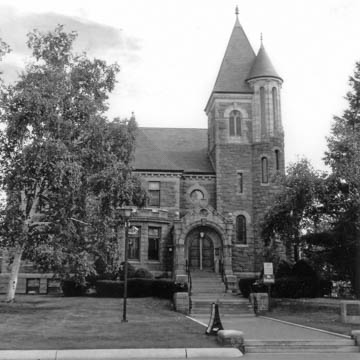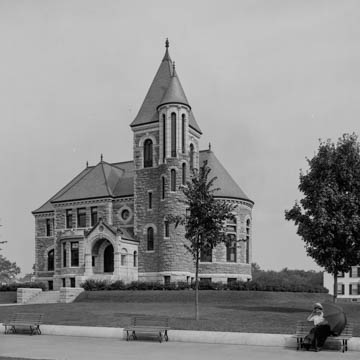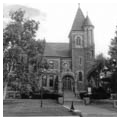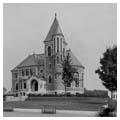Located on the northeast side of Veterans Square is the Gale Memorial Library, the most impressive municipal building in the city and one of the finest library buildings in New Hampshire. Constructed from plans by Boston architect Charles Brigham, formerly of the firm of Sturgis and Brigham, the library, like the Laconia Railroad Station, is an outstanding, highly articulated example of Romanesque Revival architecture. The building contract was let to E. Noyes Whitcomb and Company, also of Boston. Complex in form and plan, the library main block, paralleling Main Street, terminates in a semicircular apse with a half conical roof. Attached to the front, facing the square, is a pavilion with a slightly lower hipped roof. The main entrance—a projecting, one-story, gable-roofed porch vestibule—is southeast of the pavilion. Set in the angle between the main entrance and the semicircular end of the main block is a three-story square tower with a three-story, round corner turret, topped with pyramidal and conical roofs respectively. To the rear is the stack ell, the same height as the main block. These original sections of the building are unified by comparable wall and roof treatments utilizing red and light gray granite and red roof slate with copper ornamentation. The fenestration is highly varied, with both clear and stained glass, and the semicircular–arch motif is frequently employed. The only major exterior change to the Gale Library since its dedication was the addition in 1956–1957 of a plain, modern, brick-faced children’s room–auditorium wing, designed by architects Prescott and Erickson, and built by contractor Rolfe Camp Company, Inc. of Franklin, New Hampshire.
You are here
Gale Memorial Library
1901–1903, Charles Brigham. 695 Main St.
Coordinator:
Bryant F. Tolles Jr. and James L. Garvin
If SAH Archipedia has been useful to you, please consider supporting it.
SAH Archipedia tells the story of the United States through its buildings, landscapes, and cities. This freely available resource empowers the public with authoritative knowledge that deepens their understanding and appreciation of the built environment. But the Society of Architectural Historians, which created SAH Archipedia with University of Virginia Press, needs your support to maintain the high-caliber research, writing, photography, cartography, editing, design, and programming that make SAH Archipedia a trusted online resource available to all who value the history of place, heritage tourism, and learning.




